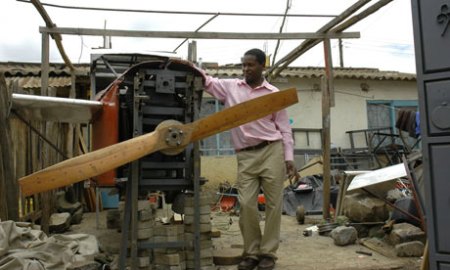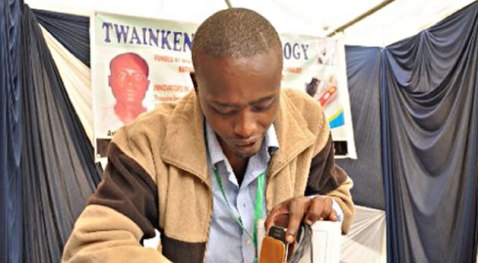If you hear the words ‘Kenyan inventions’, the first thing that comes to mind is probably the successful, overly-analyzed and praised MPesa, which is more of an innovation than an invention…and whose success is wrongly directed-similar innovations have been attempted but failed because of low adoption. How does Kenya fair on the tech- and engineering feats though?
Kenya currently ranks 53 out 142 countries on the World Economic Forum’s Global Competitiveness Index, above Turkey and Hungary.
The truth is, we are the next frontier, which is why we think we have boobs now and we should be courted like fine lasses. Here are seven (or more, I invented my own number) reasons.
#7 Elijah Kupata
What do you do when thugs break into your friend’s house and brutally murder him? Other than mourn for the obvious loss that is?
If you are one Elijah Kupata, CEO and Founder of Kupata Technologies, you can choose to address the security problem.

Kupata, seen here totally not spying on his househelp.
Kupata’s invention is a GSM-enabled remote camera which works like a normal CCTV camera. A combination of 3 G and GSM networks, the system works only on phones which are 3G (or higher)-enabled. The strategically placed camera streams images directly to the phone. “Once you have installed the system, you are assured of home security. If someone forces a door open, for example, a signal is sent to the camera then you will receive a text message on your phone notifying you about the incident. Ten seconds later, you will receive a video image of the intruder.”
Other than this primary operation, the camera can send snapshots as MMS and notify the user in case of any power failure.
The gadget goes for 30, 000, and costs 2, 500 to install.
#6 Gabriel Nderitu
We all know building a plane must take a whole lot of money, resources, and black boxes, and if you order from Boeing, a lot of patience, right? So what if you still wanted to an aerial view and you did not have all that but you have sheets of metal, a Toyota engine (apparently), wood and an uncommon pair of balls? Maybe you would store them in your mother’s garage until they are too old to matter or, if you are Gabriel Nderitu, you can build a plane!
This 42 –year old IT professional decided to challenge the Wright brothers by building his own version of the ‘homemade plane‘ (unless you live in the hangar where they make planes, then every plane is homemade). He used, as you might have already guessed, sheets of metal, a Toyota-engine, a wooden propeller and ordered some parts for the machine (it was already 2010, no need to be a dong and make everything yourself).

The pose is totally 1980 but when you have spent three years building a plane, the position of your big balls determines your pose so….oh well.
“If a guy says that ‘I want to build and aircraft’, it seems like he’s from the moon, or from somewhere. And if that happens, if it at least lifts off — even if it is three feet — it shows that you have gone somewhere.”
In case you want to be one of the few Kenyans who have attempted to build a plane (and all failed) and succeed, you can learn a few tips from WikiHow (note that the article omits –be a mad eccentric with no regard for gravity) or you can just wait for these 3D printers to be commercially available-and no, you will not be able to print Boeings from the comfort of your own home or office, at least not just yet.
Oh, as I mentioned earlier, Nderitu’s plane didn’t fly too, according to this newspiece (June 2012). He wins points for merely having the balls to try, and for making better use of the internet than researching porn and fighting over flimsy politics.
#5 Anthony Mutua, and other Electro-Kinetic variant Inventions
Mutua, like millions of other Kenyans using smartphones, especially watchmen using their phones to stay awake at night, knows only too well the pains of having the phone’s charge (or juice, if you are a techie from yesteryears) ‘die on you.’
Rather than curse the gods of Samsung, Gangnam, Apple, Sony and Techno, Mutua did something else.

This man says you can’t charge your phone using your slippers. Those have other uses, like disciplining your truant children…this man understands.
The 24-year old developed a thin crystal chip (thought to be piezoelectric device, the details were not given for patent reasons) which can be fitted into shoe soles and generates electricity as you walk. How does it charge? The $46 (approx Kshs. 3, 910) device is connected to the phone via a thin extension cord. Mutua adds that ‘…the chip fits into all footwear except bedroom slippers and will last for almost three years provided the shoes don’t wear out first’ so no, you can’t walk around the bedroom in it when KPLC decides to now give the P and the L.
The innovation is not exactly new, Ashley Taylor and Tom Krupenkin had developed ‘in-shoe’ technology (University of Wisconsin)-that harnesses the thermodynamic power generated from footsteps. It is supposed to go on mass production in 2013 under the brand InStep NanoPower (1-10 watts). It works by reversing an interesting scientific concept called electrowetting
Mutua’s invention can charge several phones at the same time. The electo-kinetic variant technology allows one to charge the phone while walking or immediately after the walk (the crystals can store the electric energy).
The project cost $6, 000 and was financed by the National Council of Science and Technology (yes, that exists). Once produced, it will come with a 2.5 year warranty, longer than most smarphones (and shoes)-provided the shoe is not lost or stolen (suddenly, shoejackers!).

Not pictured, condom shoes.
…and before you go all ham on this article for saying “but to give you some context, it’s not unusual for people in certain regions of Africa to walk for hours every day to go on their normal business” Think about it, and the fact that you have a car and internet connection doesn’t mean the rest of Africa does too.
—–Pedal Power-Jeremiah Murimi, and Pascal Katana (24 and 22)
Before Mutua developed the ‘shoe charging system’, two students had developed a dynamo-powered ‘smart charger’ in 2009.

I know, you last had a phone with an antenna in 2005, but you get the idea.
The two, during the first interview said “We took most of the items from a junk yard’.
Each piece retails at $4.50 (KShs. 350) and it takes about an hour of cycling to charge the phone. Their first ‘product testor’? You guessed it right, a watchman of course.
That was all before Nokia totally stole the idea and claimed it had come after ‘years of research.’ What do you do when you are a broke duo who’ve just graduated after 5 years in university and a multinational steals your idea? Well, you go all the way and sue the crap out of them!
#4 Erik Kariuki
Meet Erik, 32-years old and living in Bedfordshire, UK. Before I tell you about his invention, let me first tell you the spoiler alert parts- it involves a hamster, his pet hamster, and a fish tank. Simple, isn’t it? How much would an idea involving a fish tank, a pet hamster, and a Kenyan working the UK be worth? Almost nothing, right? Well no, he turned down a $1.2 million (98-100 million depending on exchange rate) for it.

That smug on his face must be the reason he turned down all that money. Plus a hamster for a pet, yuh, bite on that….
In the comfort of his bedroom, Kariuki combined a hamster cage with a fish tank to make an underwater housing for pets
He got the idea when he visited the underwater hotels Dubai is not famous for (the Burj Khalifa and being the world’s Gikomba are better known).

The smug again, and a house fit for (the) hamster king!
“I immediately remembered how bored my small rodent pet was just having a wheel and other traditional toys to play with. I imagined how enriched its life would be if it experienced the same euphoric feeling I was having when walking through that underwater tunnel.”
He turned down the 98 million shillings offer over a phone call. Now called Rodents Arkwatic (RodArk), the pet toy will be available in the near future.
#3 George Kabiru
George Kabiru is a busy man. He makes up more things than the typical Kenyan politician, which is to say a lot, but at least his inventions agree with the literal meaning of the word. His work cannot be contained in a single invention but into three major ones: Alarm-fitted television set, a stovebuilt of wood and windows, a manually operated washing machine, and those were all before 1st July, 2003.
-The Alarm-Fitted television
Kabiru fitted a matchbox-sized alarm into a television as a crime deterrent. Once the alarm is switched on, it goes off anytime anyone touches it. “Who will want to run down a street with a TV howling at them?” Kabiru comments wryly.
“It is a good crime deterrent,” Kabiru says. “The alarm can sound for something like eight hours.”
The Alarm is fitted at 15 and can be fitted on almost any electronics, including computers and fridges.
—The Solar Jiko
At $44 is a charcoal stove ideal for cool, high-altitude cooking, between 0900 and 1500 hrs. The stove includes an insulated wooden box with two glass windows-one for heat absorption and the other to allow heat through which is then reflected by the inner aluminum coating to penetrate the box and cook the food.
—-The Washing Machine

Granted, this was 2003, showing chest hair was still cool if you were too busy inventing things.
Kabiru’s greatest invention, by his own admission, is ‘…a plastic contained fixed to a stand and operated manually by turning a wheel.’ The $68 machine can handle a load of upto 40 kilogrammes.
Did I mention that when Kabiru was not thinking of ways to traumatise TV thieves, he was just a (bored) medical technician at the Mathari Mental Hospital? Which sort of explains some of his inventions….
#2 Richard Turere
Richard Turere is just 14 years old. In his one and half decades of living, he has been featured in a TED talk, appears on about 11, 800 results on Google Search, schools in Brookhouse International School (on a scholarship) and is reknowned contributor to wildlife conservation.

That smug again…

The secret between getting eaten by a lion, and not getting by a lion lies somewhere in this picture
How? Five flashlight bulbs, a car battery and a solar panel. He rigged up an automated lighting system from five torch bulbs around his family’s cattle stockade. The bulbs are controlled using switches and a car battery which is powered with a solar panel (which his family used to power their television set). The idea is intriguing because it is simple: the lights are pointed outwards, towards the darkness, and they flash in sequence, giving the impression that there is someone walking around the cattle barn.
Human-animal conflict is real, especially in Turere’s case where his family herds cattle, with all that fleshy and juicy meat, next to a national Park teeming with carnivorous felines The Nairobi National Park has 24 adult lions ( 8 adult males and 16 lionesses), 8 sub-adults (between 2.5- 3 years; 7 males and 1 female) and at least 8 cubs of varying ages below 1 year of age. Unlike most of the inventions on this lis, Turere did not do any keen research, at least initially, and was merely trying to protect his family’s wealth. Each installation costs about $10.

This is not the patent application design….I hope.
Oh, and he invented the system when he was 11 before a group of wildlife conservationists bumped into his brilliant invention. He has no books or access to technical information. He does not know where he gets the ideas or the knowledge, and yes, he has given him self plenty of electric shocks. Richards father James is proud of his son, and has given him space to tinker and collect bits of gadgetry. Like so many boys, Richards dream has something to do with aircraft – he wants to be an engineer.
#1
1st Science, Technology and Innovation Week 2012 runners-up
The problem with having a competition about an innovation is that some ground-breaking inventions are lost in the murkiness of being runners-up as some such as Anthony Mutua’s receive all the attention. Here is a number of them:
Joseph Onyaiti’s Electrical Brooder system: Built at a cost of KShs. 42, 000, this interesting system includes a feeder coated with a metallic gauze covering with an electrical cable attached, an automatic switch and an electrical timer. The idea is to automate the feeding process-leaving the chicks alone with the electrical brooder. It has the capacity to provide feed for upto six weeks, the growth period for most of the chicks that make it to up the food chain as ‘kuku porno’.
Vincent and the non-electric cooler: Solar refrigerators are not a new idea. Vincent took it a step further and built a cooling system that uses recyclable water, and charcoal (heating/cooling agent) instead of electricity.
Each piece goes for Shs. 25, 000.

Image sourced from www.ihub.co.ke
William, another innovator built solar panel sun tracking device-which is a mouthful for a solar panel that ‘follows the sun.’ The light dependent resistors in thesolar panel take the position of the sun, tracking it using special tools which make the panels tilt towards the sun direction…automatically, giving them the best position for optimum solar absorption.
David and his colleagues built GSM tracking devices which allow the user to do simple operations like switching on/off the lights, opening/closing doors and gates, setting alarms and turning on a cooker using the mobile phone. The series of devices use a sim card, an internet-enable mobile phone or computer and a text messaging system. “It can do many things,” said David, a young inventor, “passengers can tell how fast a car is driving and report over speeding vehicles to the police since it uses satellite tracking. When a car moves it can measure its speed and passengers can report such incidents to the police.”
Owaahh.
Africa inventions Kenya Kenyan inventions Nairobi Shoe charger solar fridge
Last modified: November 9, 2014















